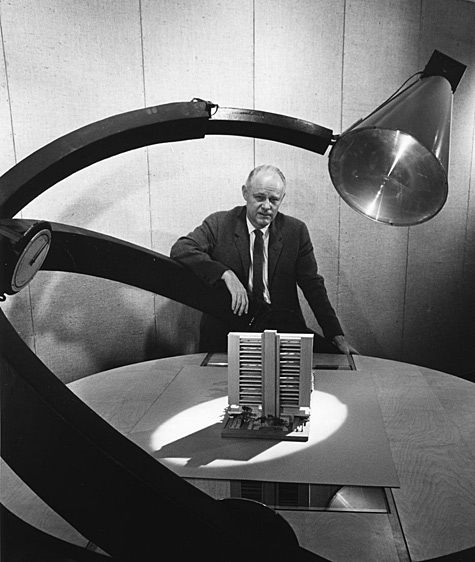
Joseph R. Passonneau, dean of the School of Architecture from 1956-67, pictured in Givens Hall in 1966 with the school’s sun-direction simulator. Passonneau died Aug. 22. He was 90.
Joseph R. Passonneau, who served as dean of the School of Architecture at Washington University in St. Louis from 1956-67, died in his sleep Monday, Aug. 22, 2011, at his home in Washington, D.C., following an extended illness. He was 90.
The son of a teacher and a farmer, Passonneau was born in 1921 in Pullman, Wash., and raised in Atwater, Minn. In 1938, he matriculated at Harvard University and, during World War II, enlisted in the Navy, serving as a code breaker for Naval Intelligence in the South Pacific.
After the war, Passonneau attended graduate school on the GI Bill, simultaneously earning a master of architecture from Harvard’s Graduate School of Design (GSD) and a master of science in engineering from the Massachusetts Institute of Technology.
He also met, and married, Janet Vivian, a doctoral candidate in biology at Radcliffe College and fellow-Minnesotan, borrowing her bicycle to commute between classes at the two institutions.
Following graduation, in 1949, Passonneau worked as a designer for Holabird & Root in Chicago, where projects included a summer auditorium for the Chicago Symphony Orchestra. Passonneau then went on to serve as chief of architectural design for the Tennessee Valley Authority, where projects included a new downtown for Oak Ridge, Tenn.
Passonneau arrived at Washington University in 1955 as a part-time design critic and was appointed dean the following year. He soon was commissioned to design the university’s new engineering building, Hugo and Ina Champ Urbauer Hall, completed in 1959. Passonneau also emerged, with architect Eugene J. Mackey, as a key lobbyist for funding of Eero Saarinen’s iconic Gateway Arch.
During his tenure as dean, Passonneau appointed a number of influential faculty, including Roger Montgomery, George Anselevicius and Fumihiko Maki, the latter a future Pritzker Prize-winner and AIA Gold medalist. Passonneau also instituted the master of urban design degree and pioneered the “4 + 2” degree structure, in which four years of undergraduate study is immediately followed by two years of graduate study, resulting in a master of architecture degree.
“Joe led the school of architecture into a modern global context through an amazing array of guests, visiting faculty, innovative new programs and curricular innovation,” says Bruce Lindsey, the current dean of architecture and the E. Desmond Lee Professor for Community Collaboration.
“I have a picture of him on my office wall, and hear often from alumni and leaders in the field of his significant influence as an architect, an educator, a teacher and a friend,” Lindsey adds. “That influence is evident in the school today and, while we mourn his passing with his family and friends, his presence here in Givens (Hall) continues.”
Cynthia Weese, who served as dean from 1993-2005, is an alumna of the school. She met Passonneau almost by chance, while visiting St. Louis as a high school student, and credits him with bringing her to campus.
“He was an extraordinary mentor to hundreds of students,” says Weese, the only woman in her graduating class. “He was very encouraging, always helpful, always there to listen, consult, guide and advise. It was just part of his character. Later, when I became dean, the very first person I called for advice was Joe.”
In 1967, Passonneau returned to Chicago and joined Skidmore Owings & Merrill. There he headed the Cross Town Design team, which designed a highway — ultimately never built — that would have crossed the city from north to south, substantially improving traffic flow while displacing minimal population.
In 1970, Passonneau launched Joseph R. Passonneau & Partners in Washington, D.C. Over the years, his firm would complete technically and politically difficult transportation projects across the United States.
Chief among these was the Glenwood Canyon stretch of Interstate 70 in Colorado. Lauded as both a work of lyric beauty and a feat of civil engineering, the terraced, four-lane highway — recipient of a Presidential Design Award given by President Bill Clinton in 2000 — balanced modern construction standards and local environmental concerns by elevating the roadway across 40 bridges and viaducts that sweep alongside the river and into a pair of 4,000-foot-long tunnels.
In addition to Washington University, Passonneau taught at Harvard’s GSD, Princeton University and the Universities of Maryland, Pennsylvania, Virginia and Southern California. In 2004, he completed Washington Through Two Centuries: A History in Maps and Images. Some 25 years in the making, the book is considered the definitive work on the urban evolution of Washington, D.C., combining archival photographs with detailed, hand-drawn land use and axonometric maps that show the city center, building by building, in 1800, 1860, 1900, 1940, 1970 and 2000.
Passonneau is survived by his wife, Janet Vivian; a son, Christopher Neal; three daughters, Rebecca Jane, Polly Nicole and Sarah Michelle; and two granddaughters, Vivian and Ada Tea.
Memorial contributions can be made to the Joseph R. Passonneau Scholarship, Washington University in St. Louis, Box 1210, One Brookings Drive, St. Louis, MO 63130.
For more information, contact Aly Abrams at (314) 935-7223 or aly.abrams@wustl.edu.